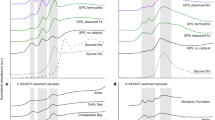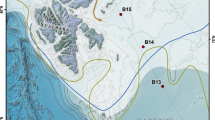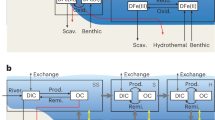Abstract
Nearly half of the global seafloor is overlain by sediment oxygenated to the basement. Yet, despite the availability of oxygen to fuel aerobic respiration, organic carbon persists over million-year timescales. Identifying the controls on organic carbon preservation requires an improved understanding of the composition and distribution of organic carbon within deep oligotrophic marine sediments. Here we show that organic carbon in sediment from the oligotrophic North Atlantic and South Pacific is low (<0.1%), yet stable to depths of 25 m and ages of 24 million years. This organic carbon is not bound in biomass and has a low carbon/nitrogen ratio. X-ray imaging and spectroscopic analyses reveal that the chemical composition of this old, deep organic carbon is dominated (40–60%) by amide and carboxylic carbon with a proteinaceous nature. We posit that organic carbon persists in oxic oligotrophic sediment through a combination of protective processes that involve adsorption to mineral surfaces and physical inaccessibility to the heterotrophic community. We estimate that up to 1.6 × 1019 g of organic carbon are sequestered on million-year timescales in oxic pelagic sediment, which constitutes an important, previously overlooked carbon reservoir.
This is a preview of subscription content, access via your institution
Access options
Access Nature and 54 other Nature Portfolio journals
Get Nature+, our best-value online-access subscription
$29.99 / 30 days
cancel any time
Subscribe to this journal
Receive 12 print issues and online access
$259.00 per year
only $21.58 per issue
Buy this article
- Purchase on Springer Link
- Instant access to full article PDF
Prices may be subject to local taxes which are calculated during checkout




Similar content being viewed by others
Data availability
The data generated by this study are available from the corresponding author upon request and will be deposited in the Biological and Chemical Oceanography Data Management Office (https://www.bco-dmo.org/data).
Change history
16 July 2019
An amendment to this paper has been published and can be accessed via a link at the top of the paper.
References
Mackenzie, F. & Lerman, A. Carbon in the Geobiosphere—Earth’s Outer Shell (Springer, Heidelberg, 2006).
Burdige, D. J. Preservation of organic matter in marine sediments: controls, mechanisms, and an imbalance in sediment organic carbon budgets? Chem. Rev. 107, 467–485 (2007).
Emerson, S. & Hedges, J. I. Processes controlling the organic carbon content of open ocean sediments. Paleoceanography 3, 621–634 (1988).
D’Hondt, S. et al. Presence of oxygen and aerobic communities from sea floor to basement in deep-sea sediments. Nat. Geosci. 8, 299–304 (2015).
D’Hondt, S. et al. Subseafloor sedimentary life in the South Pacific Gyre. Proc. Natl Acad. Sci. USA 106, 11651–11656 (2009).
Roy, H. et al. Aerobic microbial respiration in 86-million-year-old deep-sea red clay. Science 336, 922–925 (2012).
Archer, D. E., Morford, J. L. & Emerson, S. R. A model of suboxic sedimentary diagenesis suitable for automatic tuning and gridded global domains. Glob. Biogeochem. Cycles 16, 17-1–17-21 (2002).
LaRowe, D. E. & Amend, J. P. Power limits for microbial life. Front. Microbiol. 6, 718 (2015).
Middelburg, J. J. A simple rate model for organic matter decomposition in marine sediments. Geochim. Cosmochim. Acta 53, 1577–1581 (1989).
Boudreau, B. P. & Ruddick, B. R. On a reactive continuum representation of organic matter diagenesis. Am. J. Sci. 291, 507–538 (1991).
Arndt, S. et al. Quantifying the degradation of organic matter in marine sediments: a review and synthesis. Earth Sci. Rev. 123, 53–86 (2013).
Hedges, J. I. & Keil, R. G. Sedimentary organic-matter preservation—an assessment and speculative synthesis. Mar. Chem. 49, 81–115 (1995).
Mayer, L. M. The inertness of being organic. Mar. Chem. 92, 135–140 (2004).
Durbin, A. M. & Teske, A. Archaea in organic-lean and organic-rich marine subsurface sediments: an environmental gradient reflected in distinct phylogenetic lineages. Front. Microbiol. 3, 168 (2012).
LaRowe, D. E. & Van Cappellen, P. Degradation of natural organic matter: a thermodynamic analysis. Geochim. Cosmochim. Acta 75, 2030–2042 (2011).
Boye, K. et al. Thermodynamically controlled preservation of organic carbon in floodplains. Nat. Geosci. 10, 415–419 (2017).
Hartnett, H. E., Keil, R. G., Hedges, J. I. & Devol, A. H. Influence of oxygen exposure time on organic carbon preservation in continental margin sediments. Nature 391, 572–575 (1998).
Cowie, G. L., Hedges, J. I., Prahl, F. G. & de Lange, G. J. Elemental and major biochemical changes across an oxidation front in a relict turbidite: an oxygen effect. Geochim. Cosmochim. Acta 59, 33–46 (1995).
Kristensen, E., Ahmed, S. I. & Devol, A. H. Aerobic and anaerobic decomposition of organic matter in marine sediment: which is fastest? Limnol. Oceanogr. 40, 1430–1437 (1995).
Hulthe, G., Hulth, S. & Hall Per, O. Effect of oxygen on degradation rate of refractory and labile organic matter in continental margin sediments. Geochim. Cosmochim. Acta 62, 1319–1328 (1998).
Hedges, J. I. et al. Sedimentary organic matter preservation: a test for selective degradation under oxic conditions. Am. J. Sci. 292, 529–555 (1999).
Arnarson, T. S. & Keil, R. G. Changes in organic matter–mineral interactions for marine sediments with varying oxygen exposure times. Geochim. Cosmochim. Acta 71, 3545–3556 (2007).
Templeton, A. & Knowles, E. Microbial transformations of minerals and metals: recent advances in geomicrobiology derived from synchrotron-based X-ray spectroscopy and X-ray microscopy. Annu. Rev. Earth Planet. Sci. 37, 367–391 (2009).
Kallmeyer, J., Pockalny, R., Adhikari, R. R., Smith, D. C. & D’Hondt, S. Global distribution of microbial abundance and biomass in subseafloor sediment. Proc. Natl Acad. Sci. USA 109, 16213–16216 (2012).
Kaznacheyev, K. & Osanna, A. Innershell absorption spectroscopy of amino acids. J. Phys. Chem. A 106, 3153–3168 (2002).
Emerson, S. R., Hedges, J. I. & Whitehead, K. in Chemical Oceanography and the Marine Carbon Cycle (eds Emerson, S. & Hedges, J.) 261–302 (Cambridge Univ. Press, Cambridge, 2008).
Brandes, J. et al. Examining marine particulate organic matter at sub-micron scales using scanning transmission X-ray microscopy and carbon X-ray absorption near edge structure spectroscopy. Mar. Chem. 92, 107–121 (2004).
Dickens, A. F. et al. Solid-state 13C NMR analysis of size and density fractions of marine sediments: insight into organic carbon sources and preservation mechanisms. Geochim. Cosmochim. Acta 70, 666–686 (2006).
Mao, J., Tremblay, L. & Gagné, J. P. Structural changes of humic acids from sinking organic matter and surface sediments investigated by advanced solid-state NMR: insights into sources, preservation and molecularly uncharacterized components. Geochim. Cosmochim. Acta 75, 7864–7880 (2011).
Hatcher, P. G., Ravin, A., Behar, F. & Baudin, F. Diagenesis of organic matter in a 400 m organic rich sediment core from offshore Namibia using solid state 13C NMR and FTIR. Org. Geochem. 75, 8–23 (2014).
Hedges, J. I. et al. Evidence for non-selective preservation of organic matter in sinking marine particles. Nature 409, 801–804 (2001).
Schmidt, F. et al. Diagenetic transformation of dissolved organic nitrogen compounds under contrasting sedimentary redox conditions in the Black Sea. Environ. Sci. Technol. 45, 5223–5229 (2011).
Sunda, W. G. & Kieber, D. J. Oxidation of humic substances by manganese oxides yields low-molecular-weight organic substrates. Nature 367, 62–64 (1994).
Johnson, K. et al. Towards a mechanistic understanding of carbon stabilization in manganese oxides. Nat. Commun. 6, 7628 (2015).
Kwan, W. P. & Voelker, B. M. Rates of hydroxyl radical generation and organic compound oxidation in mineral-catalyzed Fenton-like systems. Environ. Sci. Technol. 37, 1150–1158 (2003).
Garrido-Ramírez, E. G., Theng, B. K. G. & Mora, M. L. Clays and oxide minerals as catalysts and nanocatalysts in Fenton-like reactions—a review. Appl. Clay Sci. 47, 182–192 (2010).
Arnarson, T. S. & Keil, R. G. Organic–mineral interactions in marine sediments studied using density fractionation and X-ray photoelectron spectroscopy. Org. Geochem. 32, 1401–1415 (2001).
Mayer, L. M. Extent of coverage of mineral surfaces by organic matter in marine sediments. Geochim. Cosmochim. Acta 63, 207–215 (1999).
Lalonde, K., Mucci, A., Ouellet, A. & Gélinas, Y. Preservation of organic matter in sediments promoted by iron. Nature 483, 198–200 (2012).
Kleber, M., Sollins, P. & Sutton, R. A conceptual model of organo-mineral interactions in soils: self-assembly of organic molecular fragments into zonal structures on mineral surfaces. Biogeochemistry 85, 9–24 (2007).
Keiluweit, M. et al. Nano-scale investigation of the association of microbial nitrogen residues with iron (hydr)oxides in a forest soil O-horizon. Geochim. Cosmochim. Acta 95, 213–226 (2012).
Rothman, D. H. & Forney, D. C. Physical model for the decay and preservation of marine organic carbon. Science 316, 1325–1328 (2007).
Boudreau, B. P., Arnosti, C., Jørgensen, B. B. & Canfield, D. E. Comment on ‘Physical model for the decay and preservation of marine organic carbon’. Science 319, 1616 (2008).
Rothman, D. H. & Forney, D. C. Response to comment on ‘Physical model for the decay and preservation of marine organic carbon’. Science 319, 1616 (2008).
Tully, B. J. & Heidelberg, J. F. Potential mechanisms for microbial energy acquisition in oxic deep- sea sediments. Appl. Environ. Microbiol. 82, 4232–4243 (2016).
Biddle, J. F., Fitz-Gibbon, S., Schuster, S. C., Brenchley, J. E. & House, C. H. Metagenomic signatures of the Peru Margin subseafloor biosphere show a genetically distinct environment. Proc. Natl Acad. Sci. USA 105, 10583–10588 (2008).
Lloyd, K. G. et al. Predominant Archaea in marine sediments degrade detrital proteins. Nature 496, 215–218 (2013).
Schmidt, F., Elvert, M., Koch, B. P., Witt, M. & Hinrichs, K. U. Molecular characterization of dissolved organic matter in pore water of continental shelf sediments. Geochim. Cosmochim. Acta 73, 3337–3358 (2009).
Schmidt, F. et al. Unraveling signatures of biogeochemical processes and the depositional setting in the molecular composition of pore water DOM across different marine environments. Geochim. Cosmochim. Acta 207, 57–80 (2017).
Whittaker, J. M., Goncharov, A., Williams, S. E., Müller, R. D. & Leitchenkov, G. Global sediment thickness data set updated for the Australian–Antarctic Southern Ocean. Geochem. Geophys. Geosystems 14, 3297–3305 (2013).
Müller, R. D., Sdrolias, M., Gaina, C. & Roest, W. R. Age, spreading rates, and spreading asymmetry of the world’s ocean crust. Geochem. Geophys. Geosyst. 9, Q04006 (2008).
Whiteside, J. H. et al. Pangean great lake paleoecology on the cusp of the end-Triassic extinction. Palaeogeogr. Palaeoclimatol. Palaeoecol. 301, 1–17 (2011).
Ehrenreich, A. & Widdel, F. Anaerobic oxidation of ferrous iron by purple bacteria, a new-type of phototrophic metabolism. Appl. Environ. Microbiol. 60, 4517–4526 (1994).
Estes, E. R., Andeer, P. F., Nordlund, D., Wankel, S. D. & Hansel, C. M. Biogenic manganese oxides as reservoirs of organic carbon and proteins in terrestrial and marine environments. Geobiology 15, 158–172 (2016).
Morono, Y., Terada, T., Kallmeyer, J. & Inagaki, F. An improved cell separation technique for marine subsurface sediments: applications for high-throughput analysis using flow cytometry and cell sorting. Environ. Microbiol. 15, 2841–2849 (2013).
Morono, Y., Terada, T., Masui, N. & Inagaki, F. Discriminative detection and enumeration of microbial life in marine subsurface sediments. ISME J. 3, 503–511 (2009).
Morono, Y. & Inagaki, F. Analysis of low-biomass microbial communities in the deep biosphere. Adv. Appl. Microbiol. 95, 149–178 (2016).
Morono, Y. et al. Assessment of capacity to capture DNA aerosols by clean filters for molecular biology experiments. Microbes Environ. 33, 222–226 (2018).
Kallmeyer, J., Smith, D. C., Spivack, A. J. & D’Hondt, S. New cell extraction procedure applied to deep subsurface sediments. Limnol. Oceanogr. 6, 236–245 (2008).
Urquhart, S. G. & Ade, H. Trends in the carbonyl core (C 1s, O 1s) → π*C=O transition in the near-edge X-ray absorption fine structure spectra of organic molecules. J. Phys. Chem. B 106, 8531–8538 (2002).
Solomon, D., Lehmann, J., Kinyangi, J., Liang, B. & Schafer, T. Carbon K-edge NEXAFS and FTIR-ATR spectroscopic investigation of organic carbon speciation in soils. Soil Sci. Soc. Am. J. 69, 107–119 (2005).
Hitchcock, A. P. aXis 2000—Analysis of X-ray Images and Spectra (Accessed 6 January 2015); http://unicorn.chemistry.mcmaster.ca/axis/aXis2000-windows-pre-IDL8.3.html
R Core Team R: A Language and Environment for Statistical Computing (R Foundation for Statistical Computing, Vienna, 2015).
Acknowledgements
The authors thank D. Repeta, B. Kocar and J. Biddle for their insight as well as C. Anderson, A. Dunlea, C. McKinley and R. Scudder for meaningful conversations. We thank C. Johnson at the WHOI Mass Spectrometry Facility for his work in analysing organic carbon samples and the captain, crew, coring crew and science party of R/V Knorr expedition 223 for facilitating the sample acquisition. Portions of this material are based on work supported while R.W.M. was serving at the National Science Foundation. Portions of this research were conducted at the Stanford Synchrotron Radiation Lightsource and Advanced Light Source. The use of the Stanford Synchrotron Radiation Lightsource, SLAC National Accelerator Laboratory, is supported by the US Department of Energy, Office of Science, Office of Basic Energy Sciences under contract no. DE-AC02-76SF00515. The use of the Advanced Light Source is supported by the US Department of Energy, Office of Science, Office of Basic Energy Sciences under contract no. DE-AC02-05CH11231. This research was supported in part by NSF GRF 1122374 to E.R.E., a NSF Center for Dark Energy Biosphere Investigations (C-DEBI, OCE-0939564) graduate fellowship to E.R.E. and C-DEBI research grant no. CH20655 awarded to C.M.H. Expedition KN223 was funded by the NSF Division of Ocean Sciences (grant no. 1433150 to A.J.S., S.D’H. and R.P.). This work is C-DEBI contribution 450.
Author information
Authors and Affiliations
Contributions
E.R.E. and C.M.H. originally conceived and developed the project with input from R.P., S.D’H., R.W.M., A.J.S. and S.D.W. R.W.M. and A.J.S. served as the chief scientist and head of the geochemistry lab, respectively, on R/V Knorr expedition 223 on which E.R.E. sailed and collected samples, and S.D’H. and R.P. additionally contributed to funding and managing the expedition. E.R.E. collected and analysed data and D.N. assisted in the collection and processing of NEXAFS data. R.P. conducted the global integration calculations. N.X., Y.M. and F.I. facilitated and conducted the cell counts. E.R.E wrote the manuscript with significant assistance from C.M.H.
Corresponding author
Ethics declarations
Competing interests
The authors declare no competing interests.
Additional information
Publisher’s note: Springer Nature remains neutral with regard to jurisdictional claims in published maps and institutional affiliations.
Supplementary information
Supplementary Information
Supplementary Figures 1–5, Supplementary Table 1.
Rights and permissions
About this article
Cite this article
Estes, E.R., Pockalny, R., D’Hondt, S. et al. Persistent organic matter in oxic subseafloor sediment. Nature Geosci 12, 126–131 (2019). https://doi.org/10.1038/s41561-018-0291-5
Received:
Accepted:
Published:
Issue Date:
DOI: https://doi.org/10.1038/s41561-018-0291-5
This article is cited by
-
Good fisheries management is good carbon management
npj Ocean Sustainability (2024)
-
An abundant bacterial phylum with nitrite-oxidizing potential in oligotrophic marine sediments
Communications Biology (2024)
-
Organic carbon source controlled microbial olivine dissolution in small-scale flow-through bioreactors, for CO2 removal
npj Materials Degradation (2024)
-
A unique subseafloor microbiosphere in the Mariana Trench driven by episodic sedimentation
Marine Life Science & Technology (2024)
-
Genome characterization of two novel deep-sea sediment fungi, Penicillium pacificagyrus sp. nov. and Penicillium pacificasedimenti sp. nov., from South Pacific Gyre subseafloor sediments, highlights survivability
BMC Genomics (2023)



